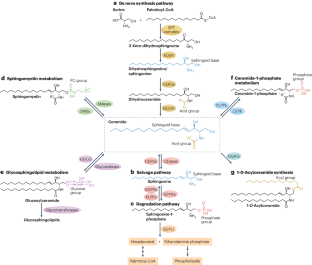调节细胞和全身的鞘脂平衡
IF 90.2
1区 生物学
Q1 CELL BIOLOGY
引用次数: 0
摘要
150 年前,约翰-图迪库姆(Johann Thudichum)将鞘脂描述为大脑中不寻常的 "斯芬克斯样 "脂质。今天,我们知道成千上万的鞘脂分子在胚胎发育和正常生理过程中介导着许多重要功能。此外,鞘脂代谢和信号通路在多种病症中失调,针对鞘脂的治疗药物目前已被用于治疗多种人类疾病。然而,我们对鞘脂在细胞和机体水平上的调控及其在发育、生理和病理环境中的功能的了解还很有限。在本综述中,我们将讨论不同细胞器中的鞘脂通路的最新进展、分泌的鞘脂介质如何调节生理和疾病、鞘脂靶向治疗和诊断研究的进展以及微生物群和哺乳动物之间的跨细胞鞘脂代谢网络。鞘脂生物学的研究进展加深了人们对哺乳动物生理学的了解,并可能在许多疾病的治疗方面取得进展。本文章由计算机程序翻译,如有差异,请以英文原文为准。


Regulation of cellular and systemic sphingolipid homeostasis
One hundred and fifty years ago, Johann Thudichum described sphingolipids as unusual “Sphinx-like” lipids from the brain. Today, we know that thousands of sphingolipid molecules mediate many essential functions in embryonic development and normal physiology. In addition, sphingolipid metabolism and signalling pathways are dysregulated in a wide range of pathologies, and therapeutic agents that target sphingolipids are now used to treat several human diseases. However, our understanding of sphingolipid regulation at cellular and organismal levels and their functions in developmental, physiological and pathological settings is rudimentary. In this Review, we discuss recent advances in sphingolipid pathways in different organelles, how secreted sphingolipid mediators modulate physiology and disease, progress in sphingolipid-targeted therapeutic and diagnostic research, and the trans-cellular sphingolipid metabolic networks between microbiota and mammals. Advances in sphingolipid biology have led to a deeper understanding of mammalian physiology and may lead to progress in the management of many diseases. Sphingolipids are a heterogeneous group of lipids with important roles in membrane form and function, cell signalling, and development. This Review discusses the regulation of sphingolipid metabolism at the subcellular and organismal levels and explores the therapeutic potential of targeting sphingolipids in human diseases.
求助全文
通过发布文献求助,成功后即可免费获取论文全文。
去求助
来源期刊
CiteScore
173.60
自引率
0.50%
发文量
118
审稿时长
6-12 weeks
期刊介绍:
Nature Reviews Molecular Cell Biology is a prestigious journal that aims to be the primary source of reviews and commentaries for the scientific communities it serves. The journal strives to publish articles that are authoritative, accessible, and enriched with easily understandable figures, tables, and other display items. The goal is to provide an unparalleled service to authors, referees, and readers, and the journal works diligently to maximize the usefulness and impact of each article. Nature Reviews Molecular Cell Biology publishes a variety of article types, including Reviews, Perspectives, Comments, and Research Highlights, all of which are relevant to molecular and cell biologists. The journal's broad scope ensures that the articles it publishes reach the widest possible audience.

 求助内容:
求助内容: 应助结果提醒方式:
应助结果提醒方式:


